written and photographed by Carl Duncan
Vol. 9 No. 6
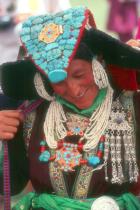 “Jullay! Jullay!” We hear it everywhere, from the summits of breathtaking passes to the giant prayer wheels in Leh. It’s a word of friendly welcome in Ladakh, or Little Tibet, a region of continuous Tibetan Buddhism culture dating back more than 1,000 years. It’s an image of Tibetan culture that is, as one guidebook put it, “perhaps now more appropriate to Ladakh than to Tibet itself.”
“Jullay! Jullay!” We hear it everywhere, from the summits of breathtaking passes to the giant prayer wheels in Leh. It’s a word of friendly welcome in Ladakh, or Little Tibet, a region of continuous Tibetan Buddhism culture dating back more than 1,000 years. It’s an image of Tibetan culture that is, as one guidebook put it, “perhaps now more appropriate to Ladakh than to Tibet itself.”
This high-altitude desert, rimmed in rainbow-colored mountains, opened its doors to the outside world in 1974 allowing budget travelers the opportunity to discover a region where they could escape the summer heat of South India’s Goa. In Ladakh, travelers encountered local people as outgoing as they were outlandish; beads, headgear, mystical rituals and magical festivities were commonplace. They dubbed this exotic desert in the sky “Moonland,” and it’s easy to see why.
Like most visitors, my wife Maria and I intend to tour some of the historic Tibetan monasteries and trek over a pass or two (Ladakh, pronounced LE DAK, means “land of the passes” in Tibetan). The spectacular 70-minute flight from New Delhi took us over massive Himalayan snowfields, then the drier crags of the Ladakh Range, before landing on the Tibetan Plateau near the Indus River–straight east of Srinagar — a landscape of near-alien starkness and beauty. We have left Hindu India, the monsoons and the subcontinent behind and are now geographically, culturally and historically inside Old Tibet. Few of the world’s countries can claim such a contrast…
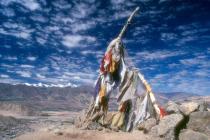 The 17th century kingdom originally extended into the country of Nepal. By 1834, the maharajah of Jammu was able to annex Ladakh and purchased Kashmir (10 years later) from the East India Company. This region became the Indian state of Jammu and Kashmir in 1948. Being part of India saved Ladakh from almost certain destruction.
The 17th century kingdom originally extended into the country of Nepal. By 1834, the maharajah of Jammu was able to annex Ladakh and purchased Kashmir (10 years later) from the East India Company. This region became the Indian state of Jammu and Kashmir in 1948. Being part of India saved Ladakh from almost certain destruction.
When Communist Chinese invaded Tibet in 1950, the ensuing Cultural Revolution savagely destroyed much of Buddhist culture. Ladakh today remains “the most significant representative of the greater Tibetan cultural area that once existed,” according to noted Tibetologist David Snellgrove of the University of London. (Only last summer, New Delhi granted Ladakh Autonomous Hill Council status, recognizing its unique culture by giving it some measure of self-rule.)
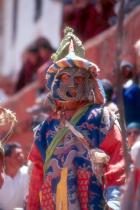 This culture and the incomparable trekking, which are unaffected by the monsoons that plague nearby Nepal, draw more and more people every year. Although the numbers are small – estimates are under 35,000 visitors a year — the summer season is very short.
This culture and the incomparable trekking, which are unaffected by the monsoons that plague nearby Nepal, draw more and more people every year. Although the numbers are small – estimates are under 35,000 visitors a year — the summer season is very short.
As we stepped from the plane, our lungs clutched for oxygen–Leh (population 3,000) sits 11,500 feet above sea level — and our eyes blink at the ethereal clarity of the desert air. On either side of the wide, gently sloping Indus valley, 20,000-foot peaks jab skies of lapis-lazuli blue. They call it “Tibetan blue.” A sign at the tiny airport warns about altitude sickness, lists the symptoms and advises visitors to take it easy for the first two or three days. But hey, I think, as I watch the unloading of duffels, backpacks, wooden crates, even a motorbike unload, I feel fine.
And I feel fine as we drive past the mani walls built up of piles of prayer stones left by pilgrims and through a field of whitewashed chortens (reliquaries) into Leh, the old capital of the kingdom. Three hours later, however, after a breakfast of omelets and tea at the Oriental Guesthouse, I am flat on my back with all the warned-of altitude-sickness symptoms: headache,dizziness and terminal lassitude. Maria, on the other hand, is happily chatting with her friend Cynthia Hunt, an aid worker who has spent the past few years here, winters included. (“It gets down to minus 40 and 50 degrees centigrade” she says.) Cynthia works with the 6,000 or so Tibetan refugees who have been filtering into Ladakh since 1962, when the Chinese exacted their control over the western part of Tibet, driving the nomads out and into Ladakh.
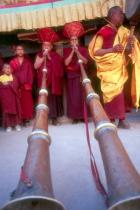 For the next three days, we acclimatize by strolling around town. Leh sits in a side valley lush with poplars and willows and vegetable gardens. Such irrigated land is scarce in Ladakh, and looking across the main Indus valley the eye scans a landscape of sand and stone and deeply fissured snow-capped mountains. Tibetan and Kashmiri shops line the single main street that doglegs through town. Being the primary bazaar between Srinagar and Manali, old-fashioned general stores stock every necessity and then some. We find Bhutanese baked beans, Danish cocktail sausages, American peanut butter, good coffee and cans of Goa tuna.
For the next three days, we acclimatize by strolling around town. Leh sits in a side valley lush with poplars and willows and vegetable gardens. Such irrigated land is scarce in Ladakh, and looking across the main Indus valley the eye scans a landscape of sand and stone and deeply fissured snow-capped mountains. Tibetan and Kashmiri shops line the single main street that doglegs through town. Being the primary bazaar between Srinagar and Manali, old-fashioned general stores stock every necessity and then some. We find Bhutanese baked beans, Danish cocktail sausages, American peanut butter, good coffee and cans of Goa tuna.
Along the curb, Ladakhi women with long dark hair plaited and tied at the back sell fresh produce and socialize with passing neighbors. We meet mountaineers, trekkers, surfers from Australia, care workers, cultural snobs, long-distance travelers with well-used backpacks, nomads from the plateau of western Tibet, tour groups fresh from Germany and school kids clad in blue uniforms and swinging plastic canteens. In the Tibetan market, we peruse hand-held prayer wheels (in great demand as gifts) while next to us a man buys two immense brass horns. The shopkeeper tells us they are for a monastery in the neighboring Nubra River valley.
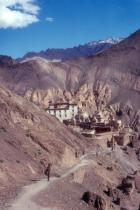 I suppose the man came by bus (the “highway” to Nubra cuts over the 18,380-foot Khardung Pass, making it the world’s highest motorable road), but with his curled up boots, swarthy face and rucksack, he has the look of someone who would just as soon have walked over the pass as wait for a lift.
I suppose the man came by bus (the “highway” to Nubra cuts over the 18,380-foot Khardung Pass, making it the world’s highest motorable road), but with his curled up boots, swarthy face and rucksack, he has the look of someone who would just as soon have walked over the pass as wait for a lift.
Our first monastery, and one of our favorites was Sankar, a short walk above Leh. The picturesque path to the monastery begins behind the Leh Mosque and meanders past terraced fields and flat-roofed farmhouses flowing with prayer flags. The best time to visit is during morning puja (offering). Arriving early, a monk near the entrance whispers “Jullay” and motions us in. We slip off our sandals and take a bench in the shadows. It is a classic Tibetan-style dukhang (assembly hall). Brocaded thangkas and banners hang from the skylight between profusely decorated pillars; murals of wrathful and benign deities and Tantric mandalas cover the walls; Tibetan carpets cover the benches; and incense swirls before bronze images. Our presence elicits hardly a glance from the intense monks who continue their quick, compelling, hypnotic chanting and drumming. We sit for an hour feeling quite privileged, the only visitors.
At intervals, the chanting tapers off, the head lama picks up bell and vajra (thunder bolt symbol) and a startling note rings out. Then the chanting and drumming resume; a scene quite unlike the Buddhist ceremonies one normally sees in Southeast Asia. This is Vajrayana (the lightning vehicle), or Tantric Buddhism. The Tantras (texts dating from 7th century India) outline techniques for generating deep religious experiences. Tibetan Buddhism incorporates these techniques. All this Tantracism requires lamas, or initiates, to interpret the veiled texts. The most famous lama today is the Dalai Lama, spiritual and political leader of Tibet, now living in Dharamsala, India. His summer palace, however, stands just outside Leh.
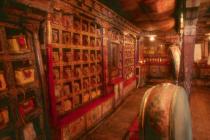 On a warm, sunny July 6 we join thousands of nomads and townspeople who are gathered on the green meadows surrounding the palace (which in fact looks like a modest two-story house) to celebrate the Dalai Lama’s birthday. White Tibetan tents and prayer flags cover the grounds. The next day is the famous Hemis festival, about an hour east of Leh. We find touring such outlying monasteries easy enough using Leh’s set-rate taxi system (with hotel pickup). An all-day excursion (Shey-Thikse-Hemis, for example) costs less than $30. Buses also ply the same routes, and you can squeeze in for practically nothing.
On a warm, sunny July 6 we join thousands of nomads and townspeople who are gathered on the green meadows surrounding the palace (which in fact looks like a modest two-story house) to celebrate the Dalai Lama’s birthday. White Tibetan tents and prayer flags cover the grounds. The next day is the famous Hemis festival, about an hour east of Leh. We find touring such outlying monasteries easy enough using Leh’s set-rate taxi system (with hotel pickup). An all-day excursion (Shey-Thikse-Hemis, for example) costs less than $30. Buses also ply the same routes, and you can squeeze in for practically nothing.
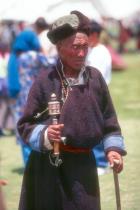 The road to Hemis winds up past miles of mani walls. As we arrive, tented tea stalls and temporary booths are doing a brisk business with the many festival-goers. For two days, Hemis monks in dramatic costumes perform in the sweltering courtyard. The stylized dances depict the power struggle between Padmasambhava — an 8th century sorcerer and saint who converted Tibet to Buddhism — and the local deities and demons. We continue to Alchi, Ladakh’s oldest intact monastery, hidden in a bend of the Indus. The dramatic two-hour drive from Leh is worth the trip in itself, although Alchi’s original 11th century murals and statues are stunning.
The road to Hemis winds up past miles of mani walls. As we arrive, tented tea stalls and temporary booths are doing a brisk business with the many festival-goers. For two days, Hemis monks in dramatic costumes perform in the sweltering courtyard. The stylized dances depict the power struggle between Padmasambhava — an 8th century sorcerer and saint who converted Tibet to Buddhism — and the local deities and demons. We continue to Alchi, Ladakh’s oldest intact monastery, hidden in a bend of the Indus. The dramatic two-hour drive from Leh is worth the trip in itself, although Alchi’s original 11th century murals and statues are stunning.
We brought our camping gear to Alchi because we planned a short trek to Sumbdah, a seldom visited monastery with murals every bit as old as Alchi’s. Although only seven air miles away, the 16,000-foot Stakna Pass stands between, nearly a vertical mile above Alchi. At the tea stalls, we learn that the pass has just opened. We are also assured that it is only a six-hour trek up.
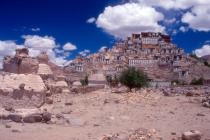 We set out at dawn on the 1,000-year-old path that quickly rises into the pristine mountains. It’s amazing to think we are only two hours out of the bustle of Leh. At 13,000 feet (according to my watch altimeter), plummeting streams clatter past on either side of us. A few yaks graze in the sparse meadows. An hour and a half later, and another thousand feet higher, we come to a stone shepherd’s hut with cheese drying on top.
We set out at dawn on the 1,000-year-old path that quickly rises into the pristine mountains. It’s amazing to think we are only two hours out of the bustle of Leh. At 13,000 feet (according to my watch altimeter), plummeting streams clatter past on either side of us. A few yaks graze in the sparse meadows. An hour and a half later, and another thousand feet higher, we come to a stone shepherd’s hut with cheese drying on top.
“Jullay!” the man calls out. Do we want a guide and a donkey? It’s tempting, but we are enjoying the alpine solitude too much and, besides, I figure, it can’t be far now. However, by 1 o’clock the trail has steepened and we’re feeling the fatigue and the altitude. We count steps to pace ourselves: 12 steps for every 30-second rest. “Who does this in six hours?” I wonder, realizing we’ve already trekked for eight hours. At 3 o’clock we’re down to a low gear crawl: Five steps and a 30-second rest. A sustainable but time-consuming pace. At 4 p.m., we approach some stone cairns, hoping to see those telltale prayer flags stationed at every pass.
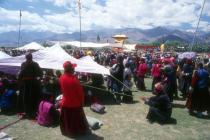 But sadly, we see only a brilliant wall of snow between the crags, another hour’s walk at least. It’s late, and we’re out of water. We return to the stream and make camp. It is a long, blustery night (34 degrees by our thermometer) but the dawn is glorious, revealing fresh snow on the peaks. I am filtering water (just above some yak dung) when a stalwart mountaineer swings down the trail spinning his prayer wheel.
But sadly, we see only a brilliant wall of snow between the crags, another hour’s walk at least. It’s late, and we’re out of water. We return to the stream and make camp. It is a long, blustery night (34 degrees by our thermometer) but the dawn is glorious, revealing fresh snow on the peaks. I am filtering water (just above some yak dung) when a stalwart mountaineer swings down the trail spinning his prayer wheel.
“Jullay! Jullay!” he bellows out. I realize I am staring at the fellow who actually does this trek in six hours. A born “Moonlander,” for him this is just a morning chum-chum. “Jullay!” I call down after him as he waves without turning around.
If you go:
Getting there: New Delhi is well-served by the major international airlines from both the east and west coasts of North America. Indian Airlines and Jet Airways serve the New Delhi/Leh route, about $107 US one way.
When to go: June to September. July is perhaps the busiest month. Lamayuru and Hemis both have summer festivals; the specific dates vary each year.
Leh is an easily walkable town and contains a main market, tourist center, airlines office, taxi stand, general post office, etc.
Several newer hotels now offer dining, money exchange, car rentals, etc. such as Hotel Laser Mo (21 rooms), Hotel Dragon (32 rooms), and Hotel Shambhala (106 rooms). These take credit cards. There are also dozens of guesthouses with character, most of these offer breakfast and dinner. Guesthouses will not have phones, so you simply walk about and find what suits you.
Getting around: Leh’s Taxi Operators Union is located below the German Bakery.
For more information: Government of India Tourist Office, 3550 Wilshire Blvd., Suite 204, Los Angeles 90010; (213) 380-8855. You can also surf around, e.g. many personal sites have up to date info – try www.indiamike.com for example and search “leh”.
